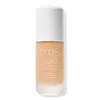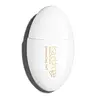RMS Beauty Suncoverup Super Tint Broad Spectrum SPF 50 Sunscreen Versus Lisa Eldridge Seamless Skin Enhancing Tint
What's inside
What's inside
 Key Ingredients
Key Ingredients

 Benefits
Benefits

 Concerns
Concerns

 Ingredients Side-by-side
Ingredients Side-by-side

Zinc Oxide
Cosmetic ColorantWater
Skin ConditioningCoco-Caprylate/Caprate
EmollientCaprylic/Capric Triglyceride
MaskingShea Butter Ethyl Esters
EmollientGlycerin
HumectantPolyglyceryl-3 Polyricinoleate
EmulsifyingGlyceryl Oleate
EmollientMethylpropanediol
SolventSilica
AbrasiveSodium Chloride
MaskingPolyglyceryl-4 Diisostearate/Polyhydroxystearate/Sebacate
EmulsifyingCaprylyl Glycol
EmollientBisabolol
MaskingDiatomaceous Earth
AbrasiveLecithin
EmollientEthylhexyl Palmitate
EmollientEthylhexyl Stearate
EmollientStearalkonium Hectorite
Gel FormingPolyglyceryl-3 Diisostearate
EmulsifyingPhenylpropanol
MaskingSimmondsia Chinensis Seed Oil
EmollientTocopherol
AntioxidantOlea Europaea Oil Unsaponifiables
Skin ConditioningSqualane
EmollientC12-15 Alkyl Benzoate
AntimicrobialTetrasodium Glutamate Diacetate
Niacinamide
SmoothingCalendula Officinalis Flower Extract
MaskingCurcuma Longa Root Powder
Skin ConditioningEquisetum Arvense Leaf Extract
AstringentHemidesmus Indicus Root Powder
Skin ConditioningHypericum Perforatum Flower Extract
Skin ConditioningPisum Sativum Seed Extract
Skin ConditioningWithania Somnifera Root Extract
Skin ConditioningGlycyrrhiza Glabra Root
Skin ConditioningOlea Europaea Leaf Extract
PerfumingBenzyl Alcohol
PerfumingChenopodium Quinoa Seed Extract
Skin ConditioningHydrogenated Lecithin
EmulsifyingPotassium Sorbate
PreservativeSodium Benzoate
MaskingSodium Hydroxide
BufferingCI 77891
Cosmetic ColorantIron Oxides
CI 77491
Cosmetic ColorantCI 77492
Cosmetic ColorantCI 77499
Cosmetic ColorantZinc Oxide, Water, Coco-Caprylate/Caprate, Caprylic/Capric Triglyceride, Shea Butter Ethyl Esters, Glycerin, Polyglyceryl-3 Polyricinoleate, Glyceryl Oleate, Methylpropanediol, Silica, Sodium Chloride, Polyglyceryl-4 Diisostearate/Polyhydroxystearate/Sebacate, Caprylyl Glycol, Bisabolol, Diatomaceous Earth, Lecithin, Ethylhexyl Palmitate, Ethylhexyl Stearate, Stearalkonium Hectorite, Polyglyceryl-3 Diisostearate, Phenylpropanol, Simmondsia Chinensis Seed Oil, Tocopherol, Olea Europaea Oil Unsaponifiables, Squalane, C12-15 Alkyl Benzoate, Tetrasodium Glutamate Diacetate, Niacinamide, Calendula Officinalis Flower Extract, Curcuma Longa Root Powder, Equisetum Arvense Leaf Extract, Hemidesmus Indicus Root Powder, Hypericum Perforatum Flower Extract, Pisum Sativum Seed Extract, Withania Somnifera Root Extract, Glycyrrhiza Glabra Root, Olea Europaea Leaf Extract, Benzyl Alcohol, Chenopodium Quinoa Seed Extract, Hydrogenated Lecithin, Potassium Sorbate, Sodium Benzoate, Sodium Hydroxide, CI 77891, Iron Oxides, CI 77491, CI 77492, CI 77499
Water
Skin ConditioningCoconut Alkanes
EmollientIsodecyl Neopentanoate
EmollientGlycerin
HumectantDimethicone
EmollientPEG-30 Dipolyhydroxystearate
EmulsifyingC12-15 Alkyl Benzoate
AntimicrobialSilica
AbrasiveCoco-Caprylate/Caprate
EmollientPolyglyceryl-4 Isostearate
EmulsifyingCorn Starch Modified
AbsorbentOpuntia Ficus-Indica Seed Oil
EmollientHelianthus Annuus Seed Oil
EmollientHydrogenated Castor Oil
EmollientTocopherol
AntioxidantPropylene Carbonate
SolventSqualane
EmollientDimethicone/Vinyl Dimethicone Crosspolymer
Skin ConditioningSalicylic Acid
MaskingSodium Chloride
MaskingSodium Hydroxide
BufferingGlyceryl Caprylate
EmollientSodium Benzoate
MaskingPhenoxyethanol
PreservativeStearalkonium Hectorite
Gel FormingIron Oxides
CI 77492
Cosmetic ColorantCI 77499
Cosmetic ColorantCI 77491
Cosmetic ColorantWater, Coconut Alkanes, Isodecyl Neopentanoate, Glycerin, Dimethicone, PEG-30 Dipolyhydroxystearate, C12-15 Alkyl Benzoate, Silica, Coco-Caprylate/Caprate, Polyglyceryl-4 Isostearate, Corn Starch Modified, Opuntia Ficus-Indica Seed Oil, Helianthus Annuus Seed Oil, Hydrogenated Castor Oil, Tocopherol, Propylene Carbonate, Squalane, Dimethicone/Vinyl Dimethicone Crosspolymer, Salicylic Acid, Sodium Chloride, Sodium Hydroxide, Glyceryl Caprylate, Sodium Benzoate, Phenoxyethanol, Stearalkonium Hectorite, Iron Oxides, CI 77492, CI 77499, CI 77491
Ingredients Explained
These ingredients are found in both products.
Ingredients higher up in an ingredient list are typically present in a larger amount.
C12-15 Alkyl Benzoate is made up of Benzoic Acid and long chain alcohols. It has a low molecular weight.
C12-15 Alkyl Benzoate is an emollient and texture enhancer. Due to its solubility, it is often used in sunscreens to help evenly distribute active ingredients.
As an emollient, C12-15 Alkyl Benzoate helps soften and hydrate your skin. Emollients create a film on your skin that traps moisture within.
This ingredient has been reported to cause eye irritation.
Learn more about C12-15 Alkyl BenzoateCi 77491 is also hydrated iron III oxide. It's sole purpose is to give a red/pink hue to products.
Iron III oxides are classified as inorganic chemicals for coloring.
Synthetically created Ci 77491 is considered safer than those naturally found. This is because the synthetically created version may contain less impurities. Iron oxides are generally non-toxic and non-allergenic.
Learn more about CI 77491Ci 77492 is also hydrated iron III oxide. It's sole purpose is to give a yellow hue to products.
Iron III oxides are classified as inorganic chemicals for coloring.
Synthetically created Ci 77492 is considered safer than those naturally found. This is because the synthetically created version may contain less impurities. Iron oxides are generally non-toxic and non-allergenic.
Learn more about CI 77492Ci 77499 is also hydrated iron III oxide. It is created from mixing red and black iron oxides. This helps give shades of darkness to a product.
Iron III oxides are classified as inorganic chemicals for coloring.
Coco-Caprylate/Caprate is created from fatty coconut alcohol, caprylic acid, and capric acid.
It is a lightweight emollient. Emollients create a thin barrier on the skin to trap moisture in. This helps keep your skin hydrated and soft.
Once applied, Coco-Caprylate/Caprate is absorbed quickly and leaves a silky feel.
Coco-Caprylate/Caprate may not be fungal acne safe.
Learn more about Coco-Caprylate/CaprateGlycerin is already naturally found in your skin. It helps moisturize and protect your skin.
A study from 2016 found glycerin to be more effective as a humectant than AHAs and hyaluronic acid.
As a humectant, it helps the skin stay hydrated by pulling moisture to your skin. The low molecular weight of glycerin allows it to pull moisture into the deeper layers of your skin.
Hydrated skin improves your skin barrier; Your skin barrier helps protect against irritants and bacteria.
Glycerin has also been found to have antimicrobial and antiviral properties. Due to these properties, glycerin is often used in wound and burn treatments.
In cosmetics, glycerin is usually derived from plants such as soybean or palm. However, it can also be sourced from animals, such as tallow or animal fat.
This ingredient is organic, colorless, odorless, and non-toxic.
Glycerin is the name for this ingredient in American English. British English uses Glycerol/Glycerine.
Learn more about GlycerinSilica, also known as silicon dioxide, is a naturally occurring mineral. It is used as a fine, spherical, and porous powder in cosmetics.
Though it has exfoliant properties, the function of silica varies depending on the product.
The unique structure of silica enhances the spreadability and adds smoothness, making it a great texture enhancer.
It is also used as an active carrier, emulsifier, and mattifier due to its ability to absorb excess oil.
In some products, tiny microneedles called spicules are made from silica or hydrolyzed sponge. When you rub them in, they lightly polish away dead skin layers and enhance the penetration of active ingredients.
Learn more about SilicaSodium Benzoate is a preservative. It's used in both cosmetic and food products to inhibit the growth of mold and bacteria. It is typically produced synthetically.
Both the US FDA and EU Health Committee have approved the use of sodium benzoate. In the US, levels of 0.1% (of the total product) are allowed.
Sodium benzoate works as a preservative by inhibiting the growth of bacteria inside of cells. It prevents the cell from fermenting a type of sugar using an enzyme called phosphofructokinase.
It is the salt of benzoic acid. Foods containing sodium benzoate include soda, salad dressings, condiments, fruit juices, wines, and snack foods.
Studies for using ascorbic acid and sodium benzoate in cosmetics are lacking, especially in skincare routines with multiple steps.
We always recommend speaking with a professional, such as a dermatologist, if you have any concerns.
Learn more about Sodium BenzoateChances are, you eat sodium chloride every day. Sodium Chloride is also known as table salt.
This ingredient has many purposes in skincare: thickener, emulsifier, and exfoliator.
You'll most likely find this ingredient in cleansers where it is used to create a gel-like texture. As an emulsifier, it also prevents ingredients from separating.
There is much debate on whether this ingredient is comedogenic. The short answer - comedogenic ratings don't tell the whole story. Learn more about comegodenic ratings here.
The concensus about this ingredient causing acne seems to be divided. Research is needed to understand if this ingredient does cause acne.
Scrubs may use salt as the primary exfoliating ingredient.
Learn more about Sodium ChlorideSodium Hydroxide is also known as lye or caustic soda. It is used to adjust the pH of products; many ingredients require a specific pH to be effective.
In small amounts, sodium hydroxide is considered safe to use. However, large amounts may cause chemical burns due to its high alkaline.
Your skin has a natural pH and acid mantle. This acid mantle helps prevent harmful bacteria from breaking through. The acid mantle also helps keep your skin hydrated.
"Alkaline" refers to a high pH level. A low pH level would be considered acidic.
Learn more about Sodium HydroxideSqualane is an emollient that helps the skin hold onto moisture. It's an oily liquid that occurs naturally in certain types of fish and plant oils.
Because squalane boosts hydration in the skin, it also comes with plenty of benefits: it is an antioxidant and can help fight free radicals and skin damage. Squalane is also found to have a detoxifying effect when applied.
Squalane comes from squalene, which occurs naturally within the sebum of our skin. It is one of the oils our skin produces to keep itself hydrated. Squalane is the hydrogenated version of squalene and has a longer shelf life.
Research shows that squalane is non-irritating (even at 100% concentration).
In general, it's a fantastic ingredient. It does a great job at hydrating the skin, and it's suitable for those with sensitive skin.
The source of squalane may impact malassezia / fungal acne. This is because olive oil derived squalane can contain impurities such as fatty acids and plant waxes. Sugarcane derived squalane is recommended for anyone with malassezia concerns.
Is squalane vegan?
This depends on the source. Squalane can be derived from both plants and animals. Most squalane used in skincare comes from plants.
Please note: the source of squalane is only known if disclosed by the brand. We recommend reaching out to the brand if you have any questions about their squalane.
Read more about squalene with an "e".
Is squalane an oil?
Squalane is often called an oil, but it’s technically not; it’s a hydrocarbon, meaning it’s only made of carbon and hydrogen, unlike true oils which are triglycerides made of fatty acids and glycerol.
The term “oil-free” isn’t regulated, so companies can define it however they want. Some exclude all oils, while others just avoid mineral oil or comedogenic oils.
While some people avoid oils thinking they cause breakouts, the right kind of oil (or oil-like ingredient like squalane) can actually help balance and hydrate your skin. It’s worth testing out simple oils or squalane to see what works best for your skin.
Learn more about SqualaneStearalkonium Hectorite is a clay-derived ingredient used to thicken a product and help create a gel-like texture.
Tocopherol (also known as Vitamin E) is a common antioxidant used to help protect the skin from free-radicals and strengthen the skin barrier. It's also fat soluble - this means our skin is great at absorbing it.
Vitamin E also helps keep your natural skin lipids healthy. Your lipid skin barrier naturally consists of lipids, ceramides, and fatty acids. Vitamin E offers extra protection for your skin’s lipid barrier, keeping your skin healthy and nourished.
Another benefit is a bit of UV protection. Vitamin E helps reduce the damage caused by UVB rays. (It should not replace your sunscreen). Combining it with Vitamin C can decrease sunburned cells and hyperpigmentation after UV exposure.
You might have noticed Vitamin E + C often paired together. This is because it is great at stabilizing Vitamin C. Using the two together helps increase the effectiveness of both ingredients.
There are often claims that Vitamin E can reduce/prevent scarring, but these claims haven't been confirmed by scientific research.
Learn more about TocopherolWater. It's the most common cosmetic ingredient of all. You'll usually see it at the top of ingredient lists, meaning that it makes up the largest part of the product.
So why is it so popular? Water most often acts as a solvent - this means that it helps dissolve other ingredients into the formulation.
You'll also recognize water as that liquid we all need to stay alive. If you see this, drink a glass of water. Stay hydrated!
Learn more about WaterThis ingredient is a combination of red, black, and yellow iron oxide pigments. This combination of colors is usually found in foundation, because it results in a "skin" color.